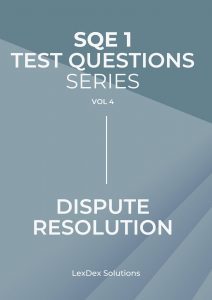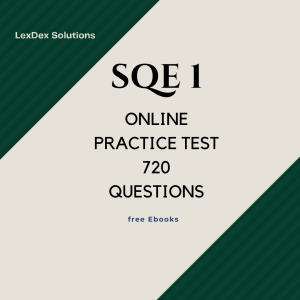SQE1 Dispute Resolution: Case Management Made Simple – for many aspiring solicitors, this phrase feels almost contradictory. The Solicitors Qualifying Exam (SQE1) is notorious for testing candidates not only on black-letter law but also on their ability to apply complex procedural rules under timed conditions. Nowhere is this more evident than in Dispute Resolution, where questions demand an understanding of case management, procedural steps, and strategic choices. While the Civil Procedure Rules (CPR) can appear overwhelming, mastering their logic is central to performing well in the exam. This guide breaks down SQE1 dispute resolution case management into practical, understandable steps so candidates can prepare confidently and effectively.
Why Case Management Matters in SQE1 Dispute
Case management is at the core of modern dispute resolution in England and Wales. The CPR gives courts broad powers to manage cases actively, ensuring disputes are resolved efficiently, proportionately, and fairly. For SQE1 candidates, understanding case management goes beyond rote memorisation — it requires grasping the practical implications of allocation, directions, and judicial discretion.
Many SQE1 dispute resolution questions present fact patterns involving allocation to tracks, interim applications, or compliance with court directions. Candidates must identify the relevant CPR provisions, apply them logically, and anticipate consequences of non-compliance. For example, knowing when a claim will be allocated to the small claims, fast track, or multi-track is not enough; candidates must also understand how this affects disclosure obligations, expert evidence, and cost management. In practice, this reflects the modern solicitor’s role: anticipating how a case will progress and advising clients strategically.
By simplifying case management into structured steps, SQE1 candidates can learn to spot the traps examiners use, such as misdirection on track allocation or misleading timeframes for compliance.
Step 1: Understanding the Overriding Objective
At the heart of case management lies the overriding objective under CPR 1.1: enabling the court to deal with cases justly and at proportionate cost. This principle underpins every decision a judge makes when exercising case management powers. For SQE1 preparation, candidates must not only memorise the overriding objective but also be ready to explain how it shapes procedural rules.
In multiple-choice questions, examiners often test whether candidates appreciate that the CPR is designed to balance fairness with efficiency. For example, directions on disclosure or expert evidence are not rigid formulas; they are guided by proportionality and fairness under the overriding objective. Missing this principle can cause candidates to misapply rules, particularly when facts suggest unequal bargaining power or disproportionate costs.
The takeaway: when faced with an SQE1 case management question, ask yourself, “What outcome would best serve the overriding objective?” That mindset aligns your reasoning with how courts — and examiners — apply the CPR.
Step 2: Allocation of Cases to Tracks
One of the most frequently examined aspects of case management in SQE1 is allocation to tracks. The CPR divides cases into the small claims track, fast track, and multi-track, with allocation decisions based on value, complexity, and importance.
Small claims track usually covers cases under £10,000, with simplified procedures and limited costs recovery.
Fast track applies to straightforward cases valued between £10,000 and £25,000, usually requiring a trial no longer than one day.
Multi-track deals with more complex or higher-value cases, requiring bespoke case management directions.
SQE1 questions often complicate allocation with tricky facts — for example, a claim valued just below the threshold but involving complex expert evidence. Candidates must remember that track allocation is not purely about value; complexity and importance are equally relevant. Understanding this nuance is essential to answering scenario-based questions correctly.
By approaching allocation logically, candidates can avoid traps and demonstrate a solicitor’s ability to foresee procedural consequences.
Step 3: Interim Applications and Court Directions
Effective case management often involves interim applications and compliance with court directions. For SQE1, candidates must be comfortable with applications such as:
Summary judgment
Strike out
Relief from sanctions
Disclosure orders
Exam questions may provide fact patterns involving missed deadlines or tactical manoeuvres, requiring candidates to identify the appropriate application and its prospects of success. For instance, relief from sanctions applications hinge on the Denton test, which weighs the seriousness of the breach, reasons for the default, and all the circumstances.
Equally, understanding court directions is crucial. Directions structure the progress of a case, dictating when disclosure, witness statements, or expert reports must be exchanged. Non-compliance carries consequences, including costs penalties or case dismissal. In SQE1 questions, these details are often tested by examining whether candidates can apply procedural rules consistently with fairness and proportionality.
Step 4: Disclosure, Evidence, and Case Progression
Case management cannot be understood without grasping disclosure and evidence rules. For SQE1, disclosure questions test knowledge of both standard disclosure and the court’s ability to order limited or extended disclosure under the CPR. Candidates must recognise when disclosure obligations arise, what documents must be included, and the sanctions for failure.
Similarly, questions about evidence often focus on expert reports or witness statements. Courts manage these carefully, balancing the need for evidence with proportionality and efficiency. For example, in fast track cases, expert evidence is usually limited to a single joint expert unless the court directs otherwise.
Case progression under judicial oversight means courts may alter disclosure or evidence requirements to keep litigation proportionate. For candidates, the key is to remember that rules are applied flexibly to achieve the overriding objective. By framing your SQE1 answers with this principle, you demonstrate not only procedural knowledge but also the solicitor’s practical mindset.
Step 5: Strategic Case Management for Exam Success
Finally, SQE1 case management questions demand strategic thinking. Examiners frequently present scenarios with competing procedural options, requiring candidates to choose the most effective and proportionate step. For instance, should a solicitor advise applying for summary judgment or proceed to trial with disclosure? Should non-compliance with directions be addressed through strike out or relief from sanctions?
Strong candidates distinguish themselves by recognising that the CPR is not rigid but strategic. The correct answer will usually reflect proportionality, fairness, and efficiency. Preparing for SQE1 dispute resolution requires repeated practice with scenario-based questions that mirror real-world client dilemmas.
LexDex Solutions provides such practice, offering SQE1 training materials with detailed explanations that teach candidates not just the rule but also the reasoning behind it. By approaching case management as a strategic process — not a memorisation exercise — candidates can simplify complex CPR rules and apply them confidently under exam conditions.
Preparing for SQE1 Dispute Resolution? Don’t just memorise the Civil Procedure Rules — learn how to apply them strategically. LexDex Solutions offers advanced SQE1 practice questions, case management scenarios, and exam strategies to help you master dispute resolution with confidence.
👉 Start your SQE1 preparation with LexDex today and take the stress out of case management.
At LexDex Solutions, we specialise in comprehensive SQE1 training resources, from multiple-choice strategies to in-depth scenario-based questions. Our materials cover every aspect of dispute resolution, ethics, land law, and more, making your preparation structured and effective. Explore our full range of SQE1 practice materials to ensure you are ready for exam day.
Of course, a solicitor’s career journey is about more than exam preparation. Presenting yourself professionally to employers is equally vital. That’s why we recommend Lawlio, a platform offering expertly designed CV templates for law graduates, trainees, and aspiring solicitors. Pairing SQE1 success from LexDex with a polished CV from Lawlio ensures you are fully prepared for both exams and career opportunities.
FAQ
1. What is case management in SQE1 dispute resolution?
Case management refers to the court’s powers under the Civil Procedure Rules to manage cases actively, ensuring they are resolved justly, efficiently, and at proportionate cost.
2. Why is track allocation important for SQE1?
Track allocation determines the procedural path a case will follow, including disclosure obligations, costs rules, and trial length. It’s a key area of SQE1 dispute resolution questions.
3. What interim applications should I focus on for SQE1?
Candidates should be familiar with summary judgment, strike out, relief from sanctions, and disclosure-related applications, as these frequently appear in scenario-based questions.
4. How does the overriding objective affect SQE1 questions?
The overriding objective under CPR 1.1 shapes all case management decisions. Examiners test whether candidates understand that fairness and proportionality guide procedural outcomes.
5. How can I improve my case management skills for the SQE1 exam?
Practice is key. Work through scenario-based questions that test track allocation, directions, disclosure, and interim applications. LexDex Solutions provides detailed resources for this preparation.


